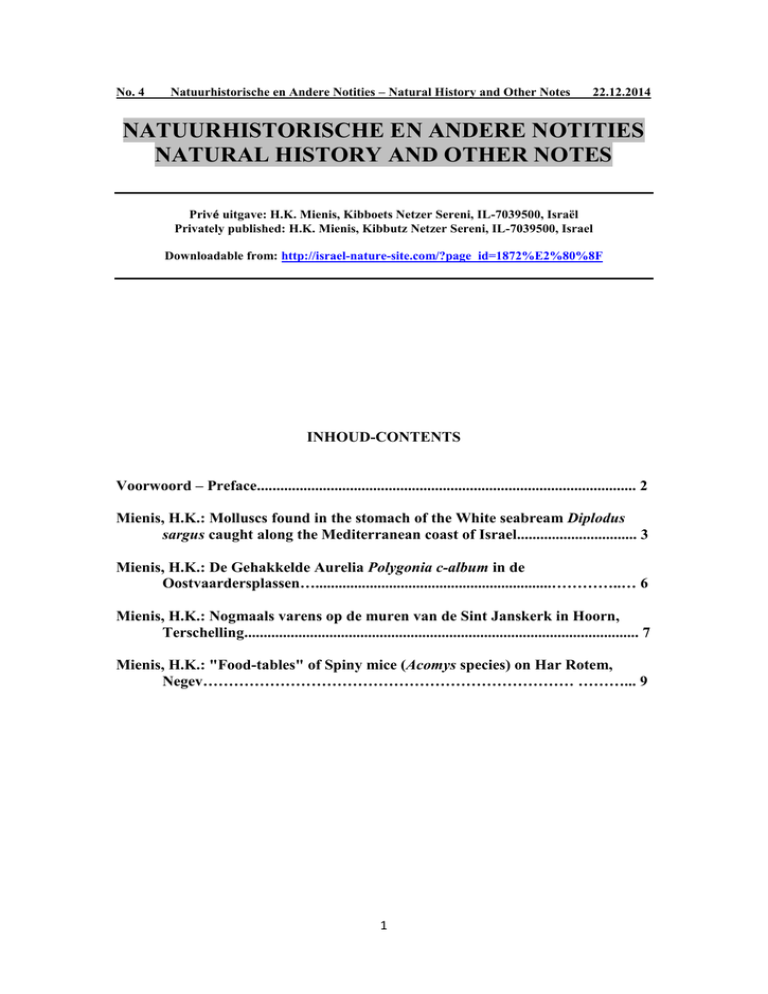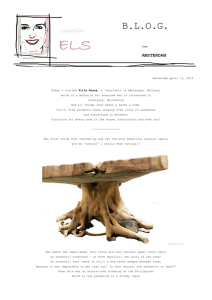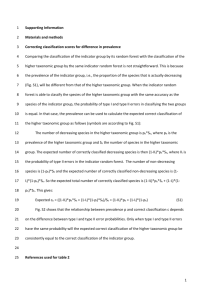natuurhistorische en andere notities natural history and other notes
advertisement

No. 4 Natuurhistorische en Andere Notities – Natural History and Other Notes 22.12.2014 NATUURHISTORISCHE EN ANDERE NOTITIES NATURAL HISTORY AND OTHER NOTES Privé uitgave: H.K. Mienis, Kibboets Netzer Sereni, IL-7039500, Israël Privately published: H.K. Mienis, Kibbutz Netzer Sereni, IL-7039500, Israel Downloadable from: http://israel-nature-site.com/?page_id=1872%E2%80%8F INHOUD-CONTENTS Voorwoord – Preface.................................................................................................. 2 Mienis, H.K.: Molluscs found in the stomach of the White seabream Diplodus sargus caught along the Mediterranean coast of Israel............................... 3 Mienis, H.K.: De Gehakkelde Aurelia Polygonia c-album in de Oostvaardersplassen….............................................................…………..… 6 Mienis, H.K.: Nogmaals varens op de muren van de Sint Janskerk in Hoorn, Terschelling...................................................................................................... 7 Mienis, H.K.: "Food-tables" of Spiny mice (Acomys species) on Har Rotem, Negev……………………………………………………………… ………... 9 1 No. 4 Natuurhistorische en Andere Notities – Natural History and Other Notes 22.12.2014 Voorwoord Dit vierde nummer van 'Natuurhistorische en Andere Notities – Natural History and Other Notes' bevat vier korte notities gebaseerd op vondsten, waarnemingen of studies gedaan in Nederland of Israël. Deze nieuwsbrief is voorlopig gepland als een kwartaal uitgave. Van elk nummer zullen 50 gelijktijdig gedrukte exemplaren verschijnen die voornamelijk bestemd zijn voor bibliotheken van instituten en museums. Daarnaast is elk nummer ook gratis electronisch verkrijgbaar via de website van mijn collega en vriend Oz Rittner: http://israel-nature-site.com/?page_id=1872%E2%80%8F Hoewel deze uitgave geheel voldoet aan de eisen die de 'Internationale Commissie voor Zoologische Naamgeving' gesteld heeft voor een wetenschappelijk tijdschrift, zullen in dit tijdschrift geen artikelen gepubliceerd worden die van invloed zijn op de naamgeving van een of andere wetenschappelijke eenheid. Artikelen mogen overgenomen worden mits de schrijver daarover geïnformeerd is en de bron genoemd wordt. Preface This fourth issue of 'Natuurhistorische en Andere Notities – Natural History and Other Notes' contains four short notes based on finds, observations or studies made in the Netherlands or Israel. This newsletter is planned for the meantime as a quarterly. Of each number 50 simultaneously printed copies will appear which are primarily intended for libraries of institutes and museums. In addition each issue is downloadable free of charge by means of the website of my colleague and friend Oz Rittner: http://israel-nature-site.com/?page_id=1872%E2%80%8F Although this publication meets the standards of a permanent scientific journal as stipulated by the 'International Commission for Zoological Nomenclature' no articles will be published in this journal which will influence the nomenclature of a certain taxonomic unit. Articles may be reprinted on the understanding that the author is informed about it and the source mentioned. 2 No. 4 Natuurhistorische en Andere Notities – Natural History and Other Notes 22.12.2014 Molluscs found in the stomach of the White seabream Diplodus sargus caught along the Mediterranean coast of Israel Henk K. Mienis National Natural History Collections, Berman Building, Hebrew University of Jerusalem, IL-91904 Jerusalem, Israël mienis@netzer.org.il Mollusken uit de magen van de Witte zeebrasem Diplodus sargus gevangen langs de Middellandse Zee kust van Israel Een onderzoek van de inhoud van tien magen van de Witte zeebrasem Diplodus sargus heeft uitgewezen dat deze vissoort zich voedt met een groot aantal weekdieren. Onder de 13 verschillende prooisoorten waren een keverslak, twee zeeslakken en tien verschillende tweekleppigen. In een maag werden bijna 90 exemplaren van de Lessepsiaanse migrant Brachidontes pharaonis gevonden. In the past I have received from one of my colleagues at the Hebrew University of Jerusalem Dr. Daniel Golani the molluscs found in the stomachs of fishes caught along the Mediterranean coast of Israel. From time to time I have dealt with such material in several short notes (Mienis, 1977a-b, 1979, 1981, 1984, 1992, 1995a-b, 1999, 2001 & 2002; Rothman & Mienis, 2011) however some investigations have been remained unreported or were dealt with only in part. In this short note I will deal once again with the molluscs found in the stomach of the White seabream Diplodus sargus (Linnaeus, 1758), Fam. Sparidae. It is an important commercially fish species living in rocky habitats down to a depth of 50 m (Golani et al., 2006). It may reach a size of 40 cm but most specimens caught along the coast of Israel range usually between 10 and 22 cm. It is a well-known predator of molluscs and to a lesser extent of crustaceans and echinoderms. Fig. 1: The White seabream (copy of a drawing in Riedl, 1963) I could study the stomach contents of 10 specimens. All of the stomachs contained remains of shells, but the number of specimens ranged from one to almost 90. 3 No. 4 Natuurhistorische en Andere Notities – Natural History and Other Notes 22.12.2014 The molluscs found in the stomachs are mentioned in Table 1 and the various species are arranged systematically in Table 2. Table 1: Molluscs found in the stomachs of 10 specimens of the White seabream Diplodus sargus caught along the Mediterranean coast of Israel. Date 20 Sept. 1982 Locality Akko 20 Sept. 1982 Akko 20 Sept. 1982 20 Sept. 1982 Akko Akko 1 Dec. 1982 Nahal Tanninim-Hadera 18 May 1992 Fish market 22 June 1992 Fish market 30 Dec. 1992 16 March 1993 28 Jan. 2002 Fish market Fish market Herzliyya-Marina Species Donax trunculus Donax venustus Donax semistriatus Donax trunculus Donax venustus Mactra stultorum Modiolus barbatus Musculus costatus Mactra stultorum Donax semistriatus Donax trunculus Donax venustus Lepidochitona corrugata Rissoina bertholleti Gregariella petagnae Modiolarca subpicta Solen marginatus Gregariella petagnae Mactra stultorum Donax trunculus Mactra stultorum Tricolia pullus Brachidontes pharaonis Minimum number 10 4 14 1 6 1 juvenile 3 1 2 juveniles 10 9 14 2 1 6 2 1 juvenile 1 1 juvenile 3 2 4 + 89 Table 2: Systematic list of molluscs found in the stomachs of the White seabream Diplodus sargus caught along the Mediterranean coast of Israel. POLYPLACOPHORA Lepidochitona corrugata (Reeve, 1848) GASTROPODA Tricolia pullus, (Linnaeus, 1758) Rissoina bertholleti Issel, 1869 BIVALVIA Brachidontes pharaonis (P. Fischer, 1870) Gregariella petagnae (Scacchi, 1832) Modiolarca subpicta (Cantraine, 1835) Modiolus barbatus (Linnaeus, 1758) Musculus costatus (Risso, 1826) Mactra stultorum (Linnaeus, 1758) Solen marginatus Pulteney, 1799 Donax semistriatus Poli, 1795 Donax trunculus Linnaeus, 1758 Donax venustus Poli, 1795 4 No. 4 Natuurhistorische en Andere Notities – Natural History and Other Notes 22.12.2014 Although the White seabream is usually associated with rocky outcrops, it is searching for food in at least three different habitats. In rocky areas it feeds at least on the chiton Lepidochitona corrugata and four species of mussels which are usually firmly attached with their byssus-threads to rocks: Brachidontes pharaonis, Gregariella petagnae, Modiolarca subpicta and Modiolus barbatus. Among algae they look for Tricolia pullus, Rissoina bertholleti and Musculus costatus, while in sandy habitats they take bivalves like Mactra stultorum, Solen marginatus, Donax semistriatus, Donax trunculus and Donax venustus. Among these prey items are two Lessepsian migrants: Rissoina bertholleti and Brachidontes pharaonis. Of the latter almost 90 specimens were found in a single stomach! Acknowledgement I like to thank my colleague Dr. Daniel Golani, curator of the Fish Collection of the Hebrew University of Jerusalem, for allowing me to study the discussed material. References Golani, D., Öztürk B. & Başusta, N., 2006. Fishes of the Eastern Mediterranean. 259 p. Turkish Marine Research Foundation, Istanbul. Mienis, H.K., 1977a. Mollusken uit de maag van de zeebaars Dicentrarchus labrax. Correspondentieblad van de Nederlandse Malacologische Vereniging, 175: 644-646. Mienis, H.K., 1977b. Arcularia circumcincta (A. Adams) uit de maag van een zeebaars. De Kreukel, 13 (1-6): 33, plt. 4. Mienis, H.K., 1979. Mollusken uit de maag van de vis Sciaena cirrosa. Correspondentieblad van de Nederlandse Malacologische Vereniging, 190: 932-933. Mienis, H.K., 1981. Molluscs from the stomach contents of the Red Squirrelfish, Adioryx ruber, caught along the Mediterranean coast of Israel. Levantina, 32: 381-383. Mienis, H.K., 1984. Kleinella fulva from the gut contents of Sciaena cirrosa. Levantina, 50: 579-580. Mienis, H.K., 1992. Rissoa lia from the stomach contents of Siganus luridus (MolluscaPisces). De Kreukel, 28 (4-5): 53-54. Mienis, H.K., 1995a. A new record of Dwarf squid for Israel, Ctenopteryx sicula in the stomach contents of a deep-water fish. Haasiana, 1: 23-24. Mienis, H.K., 1995b. A first record of the Dwarf squid Ctenopteryx sicula off the Mediterranean coast of Israel. Levantina, 82: 1-3. Mienis, H.K., 1999. Molluscs from the stomach of the White Sea Bream. Of Sea and Shore, 22 (2): 77. Mienis, H.K., 2001. Predatie op mollusken door de Gestreepte zeebrasem langs de kust van Israël in de Middellandse Zee. Spirula – Correspondentieblad van de Nederlandse Malacologische Vereniging, 321: 68. Mienis, H.K., 2002. Een geval van predatie op mossels door de Witte Zeebrasem. Spirula, 325: 27. Riedl, R., 1963. Fauna und Flora der Adria. Ein systematischer Meeresführer für Biologen und Naturfreunde. 640 p. Verlag Paul Parey, Hamburg & Berlin. Rothman, B.S. & Mienis, H.K., 2011. Smaragdia souverbiana: not only the first record from Israel, but also the oldest record from the Mediterranean Sea (Gastropoda, Neritidae). Triton, 24: 9-10. 5 No. 4 Natuurhistorische en Andere Notities – Natural History and Other Notes 22.12.2014 De Gehakkelde aurelia Polygonia c-album in de Oostvaardersplassen Henk K. Mienis Kibboets Netzer Sereni, IL-7039500 Israël mienis@netzer.org.il The Comma Polygonia c-album in the Oostvaardersplassen, Flevoland, the Netherlands The Comma, a butterfly in the family Nymphalidae, is here recorded from the Oostvaardersplassen, a nature reserve in the centre of the Netherlands. Once this species was more or less restricted to the south-east of the Netherlands, but in recent years it has been recorded from many places all over the country. De Gehakkelde aurelia Polygonia c-album, Fam. Nymphalidae, is een vlindersoort met een grote verspreiding in Noord-Afrika, Europa en Azië. In Nederland kwam deze mooie soort vooral in het zuid-oosten voor. In de laatste jaren ziet men de Gehakkelde aurelia echter steeds meer ook elders in het land. Tijdens een bezoek aan de Oostvaardersplassen op 18 oktober 2014, een mooie zonnige dag, vloog de Gehakkelde aurelia heel algemeen rond tesamen met Dagpauwogen Inachis io en Atalanta's Vanessa atalanta. Voor de Gehakkelde aurelia is dit een wat ongewoon late vliegtijd. Fig. 1: De Gehakkelde aurelia Polygonia c-album op Kale jonker Cirsium palustre Opmerkelijk was ook dat alle drie soorten overal dezelfde planten bezochten: de Kale jonker Cirsium palustre en Grote brandnetel Urtica dioica. 6 No. 4 Natuurhistorische en Andere Notities – Natural History and Other Notes 22.12.2014 Nogmaals varens op de muren van de Sint Janskerk in Hoorn, Terschelling Henk K. Mienis Kibboets Netzer Sereni, IL-7039500 Israël mienis@netzer.org.il Once again ferns on the walls of the Sint Janschurch in Hoorn, Terschelling Another view on the ferns growing on the northern walls of the St. Janschurch in Hoorn, Terschelling, the Netherlands, revealed that not only Wall-rue Asplenium ruta-muraria is growing on the buttresses of this old church but also a few specimens of the Common polypode Polypodium vulgare. Contrary to the Wall-rue which is only found on the walls, the Common polypode is growing also on the ground in the corners formed by the buttresses and the northern wall of the church. In oktober 2014 heb ik opnieuw de muren van de oude Sint Janskerk in Hoorn op Terschelling onderzocht op de aanwezigheid van muurplanten. Ook nu trof ik net als in de herfst van 2013 alleen Muurvarens Asplenium ruta-muraria aan op de noordkant van de kerk (Mienis, 2014). Alleen de steunberen waren begroeid met deze varen. Dat is een wat vreemde plaats voor deze Muurvaren daar volgens Segal (1969) Asplenium ruta-muraria in het noorden van Nederland (in de provincies Friesland, Drente en Groningen) bijna altijd op de meer zonnige zuid en west-kant van de oude kerken groeit. Tot mijn verrassing trof ik tussen de Muurvarens ook enkele exemplaren van de Gewone eikvaren Polypodium vulgare aan (Fig. 1). Exemplaren van deze op Terschelling vrij algemeen voorkomende varensoort (Kok & van Mansvelt, 2014) groeien ook op de grond in de hoeken gevormd door de steunberen en de kerkmuur (Fig. 2). Hoewel vondsten van Asplenium ruta-muraria en Polypodium vulgare op een en dezelfde muur bekend zijn uit het buitenland (Segal, 1969, Tabel 38) is dit verre van een gewone zaak in Nederland. In de duinen komt de Gewone eikvaren meestal op de naar het noorden liggende hellingen voor (Weeda et al., 1985), terwijl zij op Terschelling ook op beschaduwde plekken in de loof- en naaldbossen te vinden is (Kok & van Mansvelt, 2014). Mogelijke veranderingen in de muurvegetatie van het kerkje in Hoorn zal ook in de komende jaren gevolgd worden. Geraadpleegde literatuur Kok, J.P. & Mansvelt, E. van, 2014. Terschellinger Wilde Planten. 96 p. Isola Arte & Staatsbosbeheer. Mienis, H.K., 2014. Muurvarens op de Sint Janskerk in Hoorn, Terschelling. Natuurhistorische en Andere Notities – Natural History and Other Notes, 2: 6. Segal, S., 1969. Ecological notes on wall vegetation. 325 p. Ph.D.-proefschrift, Universiteit van Amsterdam. (Uitgeverij Dr. W. Junk N.V., Den Haag) Weeda, E.J., Westra, R., Westra, Ch. & Westra, T., 1985. Nederlandse Oecologische Flora. Wilde planten en hun relaties, 1: 304 p. I.V.N. 7 No. 4 Natuurhistorische en Andere Notities – Natural History and Other Notes Fig. 1. Een Gewone eikvaren tussen twee plukken Muurvarens op een steunbeer. 22.12.2014 Fig. 2. Gewone eikvarens in een hoek gevormd door een steunbeer en de muur. 8 No. 4 Natuurhistorische en Andere Notities – Natural History and Other Notes 22.12.2014 "Food-tables" of Spiny mice (Acomys species) on Har Rotem, Negev Henk K. Mienis The Steinhardt Museum of Natural History and National Research Center, Tel Aviv University, IL-6997801 Tel Aviv, Israel mienis@netzer.org.il "Voedsel-tafels" van Stekelmuizen (Acomys species) op Har Rotem, Negev, Israël Twee foto's vertonen de zogenaamde "voedsel-tafels" van Stekelmuizen (Acomys species) op Har Rotem, 7 km ten zuid-oosten van Dimona in de Negev woestijn. In feite zijn het de onverteerbare overblijfselen van slakken die niet alleen voor het vlees maar vooral voor het water genuttigd worden. On a recent fieldtrip to Har Rotem, some 7 km south-east of Dimona, hundreds of specimens were seen of land snails which were apparently predated upon by rodents. On the east slope of Har Rotem the shells were scattered thinly over the whole area, however on the south slope most damaged shells were seen in dense concentrations. Such accumulations of broken shells were so conspicuous that they could be seen from far away as white patches on the slope. All turned out to be near crevices in or under rocky outcrops (Fig. 1), which were apparently used as hide-outs for small Fig. 1: A "Food-table" of a Spiny mouse Acomys species near a hide-out under a rocky outcrop on the south slope of Har Rotem, Negev. rodents most likely Spiny mice Acomys species. Since both the Cairo spiny mice Acomys cahirinus and the Golden spiny mouse Acomys russatus are probably living on Har Rotem (Shalmon, 1993), the exact predator of the snails remained unknown. 9 No. 4 Natuurhistorische en Andere Notities – Natural History and Other Notes 22.12.2014 Such concentrations of shells are called "food-tables" ("shulkhanot-achila") in Hebrew, but in fact they form the unpalatable leftovers of snails which were predated upon by these rodents not only for their flesh but especially for their water contents. Fig. 2: Close-up of the shells in Fig. 1 showing predated specimens of exclusively Xerocrassa seetzenii and Sphincterochila zonata. All the shells showed the same type of damage: a large part of the whorls was gnawed away. This allowed the Spiny mice to extract in an easy way the edible parts of the snail. Most of the predated snails belonged to two species: Sphincterochila zonata and Xerocrassa seetzenii, which are characteristic species for the Negev desert. Now and then also a specimen of the large Levantina spiriplana lithophaga was found in such "food-tables". Other species living on Har Rotem like Euchondrus albulus, Buliminus therinus and Sphincterochila prophetarum were not encountered in these snail accumulations. References Shalmon, B., 1993. A field guide to the land mammals of Israel their tracks and signs. 216 p. Keter Publishing House Ltd., Jerusalem. (in Hebrew) 10

